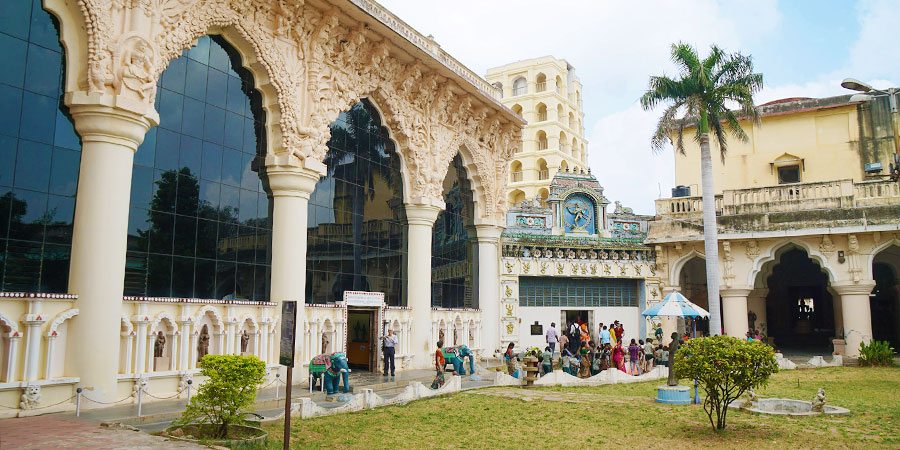Thanjavur Maratha Palace, Tanjore: The Palace that Speaks of South Indian Tradition
If you are at Tanjore, and find the auto rickshaws and buses calling for ‘Aranmanai’, know that they are going to the Thanjavur Maratha Palace Complex – the official residence of Tanjore rulers, the Bhonsle’s.Thanjavur Maratha Palace, Tanjore was originally named Sivaganga Fort, but rarely any people know it by this name. On careful observation, you can find a small moat around the palace that provided security against any unwanted access. In contrary of the conception that this Palace was built by Maratha Kings, it was actually the work of the Thanjavur Nayaks. The Marathas, however, made some changes and enhancements to suit their needs and is more popularly called "Thanjavur Aranmanai" by the people of Tamil Nadu.
Thanjavur Maratha Palace, Tanjore is a complete mix of the history and renovation. From some fantastic art and arbitrary royal paraphernalia, you can see some of the most interesting exhibits of the bygone centuries. Nayaks who took over Thanjavur in 1535 constructed this maze-like complex of the palace while another part of the structure was by a local Maratha dynasty who ruled the Tanjore 1676 to 1855.

Thanjavur Maratha Palace
|
Quick Facts
• There are seven different sections of the palace• For all these seven sections, you need three different tickets
• The Art Gallery, Saraswati Mahal Library Museum, Mahratta Darbar Hall, the bell tower, and the Saarjah Madi can be included in a single ticket
• The main entrance in the north, that crosses the East Main Street has the main ticket office which is then followed by the Maratha Palace Complex
Timings and Entry Fee:
Timings: 10:00 am – 5:00 pm, Monday to Sunday (closed on public days)Entry Fee: Rs.50
Photography Fee: Rs.30Visit Duration: 2H
Best time to visit: December to MayHistory of Maratha Palace
During the 7th century CE, Thanjavur, was a flourishing city and was the capital of the Cholas. Today, there are two important forts here - Chinna Kottai (Little fort) and Periya Kottai (Big fort). Thanjavur Palace is in the Big Fort Complex. Sevappa Nayak captured Thanjavur and became the ruler in 1532 after the Cholas lost their power in 1279 A.D.Constructed during the Thanjavur Nayak era, the Thanjavur Maratha palace, Tanjore was built during the 16th century. According to historical records, the prisoners of war were used as labourers for constructing this stunning mansion.
Till 1674, the palace (then named as Sivagangai Fort) was the official residence of the Nayak’s. After the Thanjavur Maratha annexation, the palace became the official residence of the Maratha’s. The new occupants of the mansion expanded the place and added features for its beautification.
Attractions

|
One of the most intriguing features of the palace is its extremely narrow staircases, with short steps, which takes the visitors to the higher levels. The sharp turns and low ceilings were added as a preventive measure against enemy advances especially the cavalry. It was impossible for the foot soldiers climb up the stairs at great speed. All these measures were taken because the construction was actually a fort and not a palace.
Renovation and Research Work
The building is currently under the safekeeping of the State Department of Archaeology. The ones such as Bell Tower, Arsenal Tower, Sadar Madi (Sarjah Madi) and Darbar hall of the Marathas need regular maintenance. The Raja Serfoji Memorial Hall and the Royal Palace Museum are situated in the Sadar Mahal Palace which has some interesting artefacts and needs punctual upholding. Darbar hall’s stunning paintings depicting the scenes from Ramayana along with the stucco figures of Gods and Goddesses gives this place a great appearance.• Arsenal Tower (Gooda Gopuram)
Gooda Gopuram, or the Arsenal Tower, was built in 1855 CE during Marathas reign. It is 192 feet long with eight storeys, giving the place a stunning appearance. Initially, it was used to store imported armoury, ammunition and weapons, and it monument doubled as a watchtower.The dead whale's skull is one of the most out of the ordinary exhibits of the palace. You can also get a bird view of Brihadeeswarar Temple Vimana from this tower.
• Bell Tower (Maadamaaligai)
Located on the North-western side of the Arsenal Tower is the Bell Tower. Also referred as “the wide holed ear pavilion”, the complex provides the best bird’s eye view of the Thanjavur city.There is a popular legend associated with the Bell Tower. According to the stories, Vijayaraghava Nayakkar climbed it every day to offer prayers to the Srirangam Ranganatha temple. Also, it is believed that initially, this was even higher than the present day seven storeys.
• Raja Serfoji Memorial Hall

Raja Serfoji Memorial Hall
|
The place was opened to public during the late 1997, hoping to showcase the contribution of the Maratha kings to Thanjavur and to South Indian culture and literature. Household articles, wooden and ivory objects, armouries, earthenware, costumes, gold and silver ware, manuscripts, various kinds of paintings are available on display.
Secret Chambers
There are more than three hidden chambers which were used as torture chambers to have discreet meetings. One hidden chamber is acoustically designed in the Arsenal tower and is built in a way that you can hear even the smallest whisper from three floors above.The other interesting parts of the palace
• Royal Family’s Temple• Sculptures
• Sharjah Mahdi - the Royal balcony
• Underground Tunnel
How to Reach
Located at the heart of the city, Thanjavur Maratha Palace, Tanjore is in close proximity to the Brihadeeswarar Temple. You can find the public transports such as autos and to reach this place.• By air:
Tiruchirappalli airport is the closest one
• By rail:
Thanjavur is the nearest railhead

